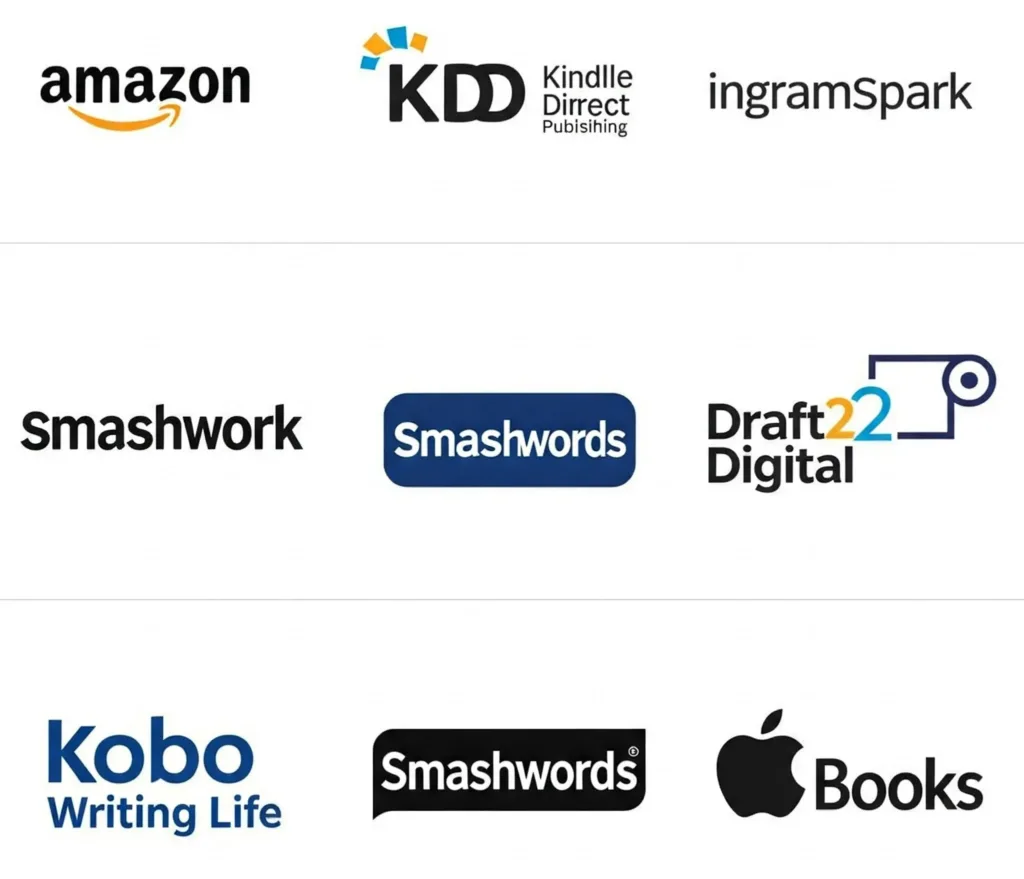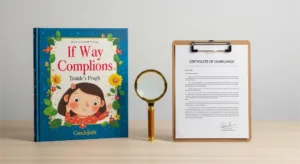Ready to bypass the gatekeepers and publish your book, your way? This streamlined guide cuts through the noise and gives you the exact steps to self-publishing success, from manuscript to marketing, specifically tailored for the US market. No fluff, just actionable advice.
To self-publish a book, complete these essential steps:
1) Thoroughly research your target market and genre conventions.
2) Write and meticulously self-edit your manuscript.
3) Hire a professional editor for content/line editing and proofreading.
4) Design an eye-catching cover (or hire a designer).
5) Format your book for both eBook and print (if applicable).
6) Obtain an ISBN and register your copyright.
7) Choose your publishing platform(s) – typically Amazon KDP and/or IngramSpark.
8) Upload your files and optimize your metadata (description, keywords, BISAC codes).
9) Develop and implement a pre- and post-launch marketing plan, focusing on building an author platform and gaining reviews.
10) Analyze your sales data and adapt your strategy for long-term growth.
This guide goes way beyond the basics. We’ve packed it with insider tips on cost-cutting, avoiding common pitfalls, and building a sustainable author career. TLDR; Self-publishing success takes strategic planning, quality production, smart distribution, and effective marketing, but gives you complete control.
II. Phase 1: Prep & Planning

Before you even type “Chapter 1” on a fresh page, taking the time to plan is crucial. This isn’t about stifling your creativity; it’s about setting yourself up for success and avoiding costly mistakes down the road.
A. Defining Your Goals: What Do You Want?
Ask yourself some key questions. Why are you writing this book? Is it a passion project, a way to generate some side income, or the first step in a full-time writing career? What do you hope to achieve with your book? Be honest with yourself about your expectations, whether it’s selling a certain number of copies, getting positive reviews, or simply sharing your story with the world. Having clear goals will help you make informed decisions throughout the entire process. Having a clear vision will provide direction.
B. Market Research & Audience Identification: Know Your Reader
This is where you become a bit of a detective. Head over to Amazon’s Kindle Store and Goodreads, and start browsing books similar to yours. Pay close attention to:
- Cover Designs: What styles are popular in your genre? Do they feature bold colors, intriguing imagery, or minimalist typography?
- Book Descriptions: What kind of language is used? Do they emphasize plot twists, emotional impact, or unique characters?
- Pricing: What’s the typical price range for eBooks and paperbacks in your genre?
- Reader Reviews: What are readers saying they love (or hate) about these books? This research will give you valuable insights into what readers expect and how you can position your book effectively. For example, if you’re writing a young adult fantasy novel, you might notice that most covers feature strong female characters and magical elements, and that readers often comment on world-building and plot pacing.Remember that the Amazon Kindle store has over 14,000 categories. Proper categorization will be key to making sure the right readers find you.
You also need to define your ideal reader, similar to establishing a solid Book Pricing Strategy. Who are they? What are their demographics (age, gender, location, interests)? The more specific you can be, the better you can tailor your writing and marketing efforts.
C. Planning your Book: Create a Road Map Whether you are a plotter or a pantser, having some idea of where your book is headed is helpful.
- Outline: You don’t need to know every detail, but a basic outline of your plot, key scenes, and character arcs can be incredibly helpful.
- Timeline: Self-publishing offers far greater flexibility in terms of publishing timelines compared to the often lengthy traditional publishing process, which can take 18 months or more. However, it’s beneficial to establish a realistic timeline for yourself to stay on track.
III. Phase 2: Writing & Editing

Now comes the heart of the process: actually writing your book! And then, just as importantly, shaping it into a polished, professional product through editing.
A. The Writing Process: Finding Your Rhythm
This is where your creativity takes center stage. But even the most inspired writers need a bit of structure to stay on track.
- Set Realistic Goals: Instead of aiming for vague targets like “write every day,” set concrete goals like “write 500 words per day” or “write for one hour each morning.” This makes your progress measurable and keeps you motivated.
- Embrace Imperfection (at First): The key to completing your first draft is to just write. Don’t get bogged down in editing or perfecting every sentence. Just get the story down on paper (or screen). You can always polish it later. As many as 97% of people who set out to write a book, never finish! Don’t become a statistic.
- Find Your Writing Zone: Experiment to find what helps you focus. Do you need complete silence, or do you work best with background music? Do you prefer writing in the morning, or are you a night owl?
B. The Editing Process: Transforming Your Draft into a Gem
Once you’ve finished your first draft, congratulations! But the work isn’t over yet. Editing is where your book truly comes to life.
- Self-Editing: After letting your manuscript “rest” for a few weeks (or even a month), approach it with fresh eyes. Read through it critically, looking for plot holes, inconsistencies, pacing issues, and awkward phrasing.
- Beta Readers: These are trusted readers (ideally not close friends or family) who can provide objective feedback on your manuscript. Find beta readers in online writing communities, local writing groups, or through services like Goodreads.
- Professional Editing: This is an investment, but it’s one of the most important ones you can make. There are different levels of editing, each serving a specific purpose:
- Developmental Editing: Focuses on the big picture – story structure, character development, pacing, and overall effectiveness.
- Line Editing: Focuses on sentence-level clarity, style, and flow.
- Copyediting: Corrects grammar, spelling, punctuation, and consistency errors.
- Proofreading: The final check for any remaining typos or formatting issues. While costs vary, expect to pay anywhere from $30-$55/hour, or several cents per word, depending on the type of editing and the editor’s experience, it is crucial to understand Self-Publishing Costs in 2025. For a 60,000-word novel, professional editing could range from $500 to $2,500+, much like the varied Book Printing Costs, but it’s a crucial step in ensuring your book is the best it can be.
“Anyone can self-publish, but not everyone will be successful at it. Success requires a combination of good writing, a professional product, and effective marketing,” says Jane Friedman, a writer, editor and professor specializing in the publishing industry, with over 20 years of experience.
IV. Phase 3: Pre-Publication
Now that your manuscript is polished and ready to go, it’s time to focus on the elements that will attract readers and make your book look professional.
A. Cover Design: Your Book’s First Impression
Never judge a book by its cover? We all know that’s not true! Your cover is the first thing potential readers will see, and it needs to grab their attention and convey the essence of your book.
- Professionalism is Key: A well-designed cover signals that you’ve taken your book seriously, and that it’s worth their time and money.
- Design Options:
- DIY: If you have design skills, you can use tools like Canva, which offers a range of templates and design elements. This is the most budget-friendly option.
- Pre-made Templates: Many websites offer professionally designed cover templates that you can customize with your book’s title and author name. This is a good middle-ground option.
- Hire a Designer: For the most professional results, consider hiring a freelance cover designer. You can find experienced designers on platforms like Upwork or Reedsy, many of which offer guidance on how to find and work with a book cover designer. Expect to pay anywhere from $500 to $2,000+ for a custom cover design, depending on the designer’s experience and the complexity of the design.
- Best Practices:
- Genre Conventions: Research the covers of bestselling books in your genre. What are the common elements?
- Clear Title and Author Name: Make sure they’re easy to read, even in thumbnail size.
- High Resolution: Use a high-resolution image to ensure your cover looks crisp and professional, both online and in print.
B. Book Formatting: Ensuring a Smooth Reading Experience
Formatting refers to the layout and presentation of your book’s interior. It’s crucial for readability and creating a professional impression.
- eBook Formatting: This involves converting your manuscript into a format suitable for e-readers (like Kindle, Kobo, and Nook). Tools like Vellum (Mac only) and Atticus make this process relatively easy, even for beginners. They handle things like chapter headings, page breaks, and font embedding automatically.
- Print Book Formatting: This is more complex, as you need to consider things like margins, page numbers, headers, footers, and font choices. You can use professional design software like Adobe InDesign, but it has a steep learning curve. Alternatively, you can hire a professional formatter, or ensure you have Print Ready Files.
- Key Considerations: *Consistent fonts *Proper Margins *Readable Line Spacing
C. Obtaining an ISBN and Copyright: Protecting Your Work
- ISBN (International Standard Book Number): This is a unique 13-digit number that identifies your book. You’ll need a separate ISBN for each format of your book (eBook, paperback, hardcover), learning 7 Steps to Get Your ISBN Number and Publish Your Book is essential.
- US Authors: You can purchase ISBNs directly from Bowker (the official ISBN agency for the US). A single ISBN costs $125, but you can buy a pack of 10 for $295, which is much more cost-effective if you plan to publish multiple books or formats. Some platforms, such as KDP, provide free ISBNs.
- Copyright: You automatically own the copyright to your work as soon as you create it. However, registering your copyright with the U.S. Copyright Office provides additional legal protection.
D. Metadata & Keywords: Making Your Book Discoverable
Metadata is the information that describes your book, such as the title, subtitle, author name, description, and keywords. It’s crucial for helping readers find your book online.
- Book Description: This is your sales pitch! Write a compelling description that hooks the reader and makes them want to learn more. Aim for around 150-200 words.
- Keywords: These are the words and phrases that readers might use to search for books like yours. Choose relevant keywords that accurately reflect your book’s content and genre.
- BISAC Codes: These are standardized codes that categorize your book by genre and subject matter. Choosing the right BISAC codes helps bookstores and libraries shelve your book correctly and helps readers find it online.
V. Phase 4: Publishing & Distribution

A. Choosing Your Self-Publishing Platform(s): Weighing Your Options
There are several major self-publishing platforms, each with its own strengths and weaknesses. Here’s a brief overview of the most popular options:
- Amazon KDP (Kindle Direct Publishing): The undisputed giant of the eBook market. KDP offers easy-to-use tools, a vast reach, and the option to enroll in KDP Select (which gives you access to promotional tools like Kindle Unlimited, but requires exclusivity). KDP also offers print-on-demand services for paperback and hardcover books.
- IngramSpark: Primarily known for its print-on-demand services, IngramSpark offers wider distribution than KDP, reaching bookstores, libraries, and online retailers worldwide. This is a great option if you want your book to be available in physical stores. IngramSpark can get your book in front of over 45,000+ retailers and libraries.
- Other Platforms: Draft2Digital, Smashwords, Kobo, and Apple Books offer alternative distribution channels, particularly for eBooks. These platforms can help you reach readers who don’t primarily use Amazon. Choosing the right platform(s) depends on your goals. If you’re primarily focused on eBooks, KDP is a strong contender. If you want the widest possible distribution for print books, IngramSpark is a good choice. You can also use a combination of platforms.
B. Uploading Your Files: Following the Guidelines
Each platform has specific requirements for file formats, cover dimensions, and metadata. Make sure you carefully follow their guidelines to avoid any issues. A pre-upload Checklist should include *ISBN *Cover File *Manuscript File *Metadata
C. Setting Your Price: Finding the Sweet Spot
Pricing your book can be tricky. You want to be competitive, but you also want to earn a fair return on your investment.
- Research Competitor Pricing: See what similar books in your genre are selling for.
- Consider Your Costs: Factor in your editing, design, and marketing expenses.
- eBook Pricing: Many self-published authors price their eBooks between $2.99 and $4.99, but this can vary depending on genre and length.
- Print Book Pricing: Print book pricing is more complex, as you need to account for printing costs. IngramSpark and KDP both provide calculators to help you determine your printing costs and royalties. *Remember, with KDP, authors can keep up to 70% of their profits.
VI. Phase 5: Marketing & Sales

Publishing your book is a huge accomplishment, but it’s only half the battle. Now you need to get it into the hands of readers. This is where marketing comes in.
“The beauty of self-publishing is that you are in control. You decide when to publish, how to price your book, and how to market it,” says Mark Dawson, bestselling author and creator of the Self-Publishing Formula.
A. Building Your Author Platform: Creating a Home Base
Your author platform is your online presence, where readers can learn more about you and your books. It’s essential for long-term success.
- Author Website: This is your central hub. It should include information about you, your books, a blog (optional), and a way for readers to contact you or sign up for your email list.
- Social Media: Choose the platforms where your target audience hangs out. If you’re writing young adult fiction, TikTok and Instagram might be good choices. If you’re writing business books, LinkedIn might be more appropriate. Don’t try to be everywhere; focus on the platforms where you can most effectively connect with your readers.
- Email List: This is arguably your most valuable marketing asset. An email list allows you to communicate directly with your readers, build relationships, and promote your books. Offer a free incentive (like a short story, bonus chapter, or checklist) to encourage sign-ups. Building an email list is crucial; it’s your direct line to your readers.
B. Pre-Launch Marketing: Building Anticipation Start generating buzz for your book before it’s released.
- Teaser Campaign: Share snippets of your book, character introductions, or behind-the-scenes glimpses of your writing process on social media.
- Cover Reveal: Build excitement by revealing your cover design a few weeks before your launch date.
- Pre-orders: Many platforms allow you to set up pre-orders for your book. This can help boost your book’s ranking on launch day.
C. Post-Launch Marketing: Sustaining Momentum Once your book is live, the real marketing work begins.
- Amazon Advertising (AMS Ads): Amazon’s advertising platform allows you to target specific keywords and audiences. Start with a small budget and experiment to see what works best.
- Social Media Advertising: Facebook, Instagram, and other platforms offer powerful advertising tools. You can target your ads based on demographics, interests, and even reading habits.
- Book Promotion Sites: There are many websites that specialize in promoting discounted or free eBooks. BookBub is the most well-known, but it’s also highly competitive. Other options include Freebooksy, Bargain Booksy, and Robin Reads.
- Reach Out to Book Bloggers and Reviewers: Send review copies of your book to bloggers and reviewers in your genre. Positive reviews can significantly boost your book’s visibility.
- Run Giveaways and Contests: Giveaways can be a great way to generate excitement and attract new readers. “Self-publishing is a marathon, not a sprint. It takes time to build an audience and establish yourself as an author,” advises David Gaughran, author and self-publishing advocate. Keep that in mind, and focus on long term connection with your readers.
VII. Common Mistakes & How to Avoid Them
Self-publishing offers incredible opportunities, but it’s also easy to make mistakes that can hurt your book’s chances of success. Here are some of the most common pitfalls and how to avoid them:
- Skipping Professional Editing: This is arguably the biggest mistake new authors make. A poorly edited book, riddled with typos and grammatical errors, will turn off readers and damage your reputation. Invest in professional editing.
- Using a Poor-Quality Cover: Your cover is your book’s first impression, and a cheap-looking or amateurish cover will deter potential readers. Invest in a professional cover design, or utilize high-quality templates.
- Neglecting Metadata Optimization: If your book’s metadata (title, subtitle, description, keywords) isn’t optimized, readers won’t be able to find it. Do your keyword research and write a compelling book description.
- Ignoring Marketing: “Build it and they will come” does not apply to self-publishing. You need to actively promote your book to reach readers. Develop a marketing plan and stick to it.
- Not Building an Email List: Your email list is your direct line to your readers. It’s one of the most effective ways to build relationships and promote your books. Start building your email list from day one.
- Having Unrealistic Expectations: Self-publishing success takes time and effort. Don’t expect to become a bestseller overnight. Set realistic goals and be patient.
VIII. Cost Breakdown & Budgeting
One of the biggest advantages of self-publishing is that you have control over your budget. However, it’s important to be realistic about the costs involved. Here’s a breakdown of potential expenses:
| Expense | DIY (Minimal Cost) | Budget-Friendly | Premium (Professional) | Notes |
|---|---|---|---|---|
| Editing: | $0 (self-edit) | $200 – $800 | $1,000 – $5,000+ | High risk of errors |
| Cover Design: | $0 – $50 (Canva) | $50 – $300 | $500 – $2,000+ | |
| Formatting: | $0 – $50 (Vellum) | $50- $100 (Atticus) | $500 – $1,500+ | |
| ISBN: | $0 (KDP free) | $125 (single) | $295 (10-pack) | |
| Marketing/Ads: | $0 | $100 – $500 | $1,000+ | |
| Totals: | $0-$50 | $475- $1750 | $2,500+ | Good balance |
- DIY: This involves doing everything yourself, using free or low-cost tools. This is the most budget-friendly option, but it requires significant time and effort, and the quality may suffer.
- Budget-Friendly: This involves using a mix of free/low-cost tools and affordable professional services (e.g., a freelance editor or a pre-made cover template).
- Premium: This involves hiring professionals for all aspects of the publishing process (editing, design, formatting, marketing). This is the most expensive option, but it typically results in the highest-quality product. It’s crucial to create a budget before you start the self-publishing process. This will help you make informed decisions about where to invest your money and avoid overspending.
IX. Long-Term Author Success
Self-publishing isn’t just about releasing one book; it’s about building a sustainable career. Here are some key strategies for long-term success:
- Analyzing Sales Data: Regularly track your book sales, reviews, and rankings. This data will help you understand what’s working and what’s not, so you can adjust your marketing efforts accordingly.
- Building Reader Relationships: Engage with your readers on social media, respond to their emails and comments, and build a community around your books, learn more skills from the article How to build relationships with readers. Loyal readers are your best advocates.
- Planning Your Next Book: The best way to sell your current book is to write and publish your next one! Consider writing a series, as this can be a highly effective way to build readership and increase sales.
X. Conclusion
Self-publishing offers unprecedented opportunities for authors to take control of their careers and share their stories with the world. It’s not always easy, but with careful planning, hard work, and a willingness to learn, you can achieve your publishing dreams. This simplified self-publishing guide is here to help. Remember, the key steps to self-publishing success are:
- Thorough Preparation: Defining your goals, researching your market, and planning your book.
- Quality Content: Writing a great book and investing in professional editing.
- Professional Presentation: Creating an eye-catching cover and ensuring proper formatting.
- Strategic Publishing: Choosing the right platform(s) and optimizing your metadata.
- Effective Marketing: Building your author platform and actively promoting your book.
- Continuous Learning: Adapting to changes and constantly improving your skills.
So, take a deep breath, embrace the challenge, and start your self-publishing journey today! You’ve got this! Don’t forget, for those wanting physical books, Mainland printing offers competitive B2B options.







